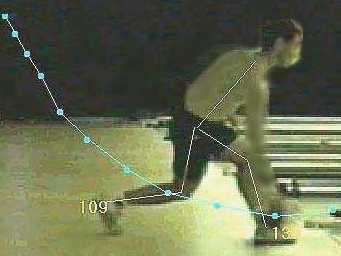- What is Biomechanics?
- How to calculate Joint and Segment Angles?
- How do I calculate Segment Velocities?
What is BIOMECHANICS?
Biomechanics is the study of movement and physics as it applies to biological systems. Using biomechanical principles, you can perform measures and do calculations to analyze bowling technique. You can calculate joint angles and segment velocities. In other words, you can measure the position of your arms and legs, in relation to each other and in relation to the ground. You can calculate how fast your arm swings and the ball speed generated. All these can help you understand your technique, compare your technique to other bowlers, and to identify deficiency areas that you need to improve upon. Below are descriptions of how to perform some basic biomechanical analysis for bowlers. See also a list of Bowling Analysis Software programs which can do a lot of this analysis for you.
How do I calculate JOINT and SEGMENT ANGLES?
An understanding of angles made by your limbs throughout the bowling technique can give you that extra information required when fine tuning your technique. There are many software programs available that will do this for you, or at least make it very easy for you to do.
If you can't afford computer software to do the job for you, fortunately there is a cheap alternative, which can be just as effective. You will need to collect video footage of the bowler. You will also need a few clear plastic sheets (like the ones used for overhead projectors), marker pens and a protractor. Tape the plastic sheets to your TV screen, play the tape and pause it at the appropriate times. With the plastic sheet over the image of the bowler, you can simply draw lines between the points of interest. Move the tape forward, and again draw the lines. Using this technique, you can obtain a good picture of your technique in stick figures. Once you remove the sheet from the screen, you can use the protractor to calculate any angles.
How do I calculate SEGMENT VELOCITIES?
 Calculating segment velocities is the next step after calculating
joint and segment angles. To do so you need to be able to calculate
distance from the video footage. You will also need to
know what the frame rate of the video recording is. It may be 25
frames per second, which means that there is 0.04 seconds between
each frame. When you view the video frame by frame, and calculate
the distance an object moves from one frame to the next, you can
calculate the velocity of that object. If the object (e.g. the
hand) moves 2 inches between frames, the equates to a velocity of
4.2 feet/sec. Get it? Don't worry as it is not that easy. I will
try and simplify all this information in the future as I update
this site.
Calculating segment velocities is the next step after calculating
joint and segment angles. To do so you need to be able to calculate
distance from the video footage. You will also need to
know what the frame rate of the video recording is. It may be 25
frames per second, which means that there is 0.04 seconds between
each frame. When you view the video frame by frame, and calculate
the distance an object moves from one frame to the next, you can
calculate the velocity of that object. If the object (e.g. the
hand) moves 2 inches between frames, the equates to a velocity of
4.2 feet/sec. Get it? Don't worry as it is not that easy. I will
try and simplify all this information in the future as I update
this site.


 Current Events
Current Events